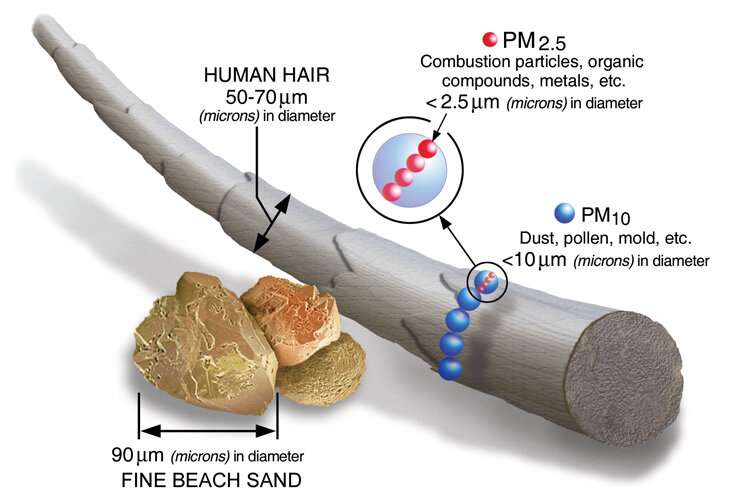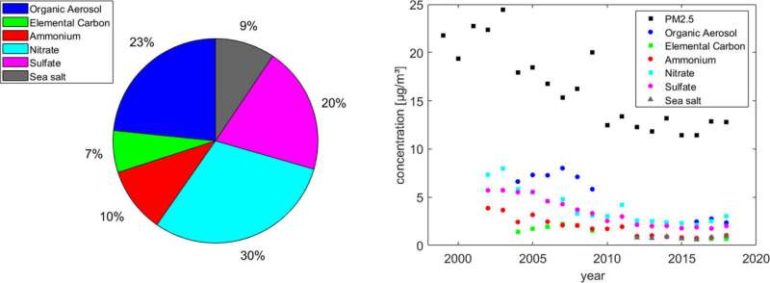California’s restrictions on vehicle emissions have been so effective that in at least one urban area, Los Angeles, the most concerning source of dangerous aerosol pollution may well be trees and other green plants, according to a new study by University of California, Berkeley, chemists.
Aerosols—particles of hydrocarbons referred to as PM2.5 because they are smaller than 2.5 microns in diameter and easily lodge in the lungs—are proven to cause cardiovascular and respiratory problems.
As a result of strict vehicle emissions laws, organic aerosol levels have been significantly reduced throughout the United States, but the drop has been particularly dramatic in Los Angeles, which started out at a higher level.
Based on pollution measurements over the past 20 years, the UC Berkeley scientists found that concentrations of PM2.5 in the Los Angeles basin in 2012 were half what they were in 1999. As a result, from 2016 to 2018, there were almost no PM2.5 violations in the area when temperatures were low, below 68 degrees Fahrenheit. But at warmer temperatures, aerosol concentrations rose—over the same time period, 70% to 80% of days over 100 F exceeded the National Ambient Air Quality Standard (NAAQS) threshold.
“The positive news is that, where we did understand the source and we took action, that action has been incredibly effective,” said Ronald Cohen, an atmospheric chemist and UC Berkeley professor of chemistry. “Twenty years ago, just about every day in LA was in violation of a health-based standard. And now it is only the hot days.”
As vehicle organic chemicals—compounds of carcinogens such as benzene and toluene —dropped, air quality experts focused on other potential sources of aerosols in those cities with unhealthful levels. Many researchers believe that personal care and household cleaning products—some seemingly as benign as the citrus scent limonene—may be the culprit. Given the temperature dependence of aerosol levels in Los Angeles, Cohen doubts that.
“There is a growing consensus that, as cars became unimportant, household chemicals are dominating the source of organics to the atmosphere and, therefore, dominating the source of aerosols,” he said. “I am saying that I don’t understand how aerosols from these chemicals could be temperature-dependent, and, therefore, I think it is likely something else. And trees are a good candidate.”
Plants are known to release more organic chemicals as the temperature rises and in many forested areas trees are the source of organic chemicals that combine with human-produced nitrogen oxides to form aerosol. President Ronald Reagan was partially correct when he infamously stated in 1981 that, “Trees cause more pollution than automobiles do.” At the time, scientists were learning about the role of forests surrounding Atlanta in causing that city’s air pollution.
Cohen and former Berkeley master’s degree student Clara Nussbaumer reviewed organic chemical emissions from various plants known to grow or be cultivated in the Los Angeles area and found that some, such as the city’s iconic Mexican fan palms, produce lots of volatile organic compounds. Oak trees are also high emitters of organic chemicals.
They estimated that, on average, 25% of the aerosols in the Los Angeles basin come from vegetation, which includes an estimated 18 million or more trees.
Plant derived aerosols are likely made of the chemical isoprene—the building block of rubber or plant chemicals such as terpenes, which consist of two or more isoprene building blocks combined to form a more complex molecule. Cohen says that PM2.5 aerosols can be thought of “as little tiny beads of candle wax,” with plant-derived aerosols composed of many molecules of isoprene and terpenes, which are found in pine tree resins.
“I am not suggesting that we get rid of plants, but I want people who are thinking about large-scale planting to pick the right trees,” he said. “They should pick low-emitting trees instead of high-emitting trees.”
The research was described this month in the journal Environmental Science & Technology.

How does global warming affect pollutants?
Cohen, who has studied the temperature dependence of urban ozone levels for insight into the impact climate change will have on pollutants, decided two years ago to investigate the temperature dependence of ozone and aerosol pollution in five counties in the Los Angeles basin: Los Angeles, San Bernardino, Riverside, Orange and Ventura. He and Nussbaumer looked at data from 22 measurement sites across the basin—eight in LA County, two in Orange County, five in Riverside County, four in San Bernardino County, and three in Ventura County—to study aerosols, and at four sites—three in LA, one in San Bernardino—to study ozone.
The researchers found that at the beginning of the 21st century, the relationship between temperature and aerosol pollution was quite varied: if the temperature went up, sometimes PM2.5 concentrations would increase a lot, sometimes a little. Today, the relationship is more linear: If the temperature goes up a degree, PM2.5 concentrations predictably increase by a set amount.
Cohen and Nussbaumer focused primarily on secondary organic aerosols (SOA), which form as particles when gaseous pollutants—primarily nitrogen oxides (NOx) and volatile organic compounds (VOCs)—react with sunlight. The same conditions produce ozone.
Using a simple atmospheric model, they concluded that both regulated chemicals from vehicle exhaust and cooking—primary organic aerosols such as benzene, toluene, ethylbenzene and xylene—and isoprene from plants were precursors of the majority of the organic aerosols observed. Their model suggests that about a quarter of the SOA in the LA Basin are formed by isoprene or other very similar compounds, and that these represent most of the temperature-dependent increase. While there is evidence that some temperature-dependent VOCs have been controlled over time, such as those from evaporation of gasoline, isoprene is not one of them.
Cohen noted that as electric car use increases, the importance of organic aerosols from vegetation will become more dominant, requiring mitigation measures to keep levels within regulatory limits during heat waves.
“Cars are also contributing to ozone, and in the LA basin the ozone level is also high, at high temperatures and for the same reason: There are more organic molecules to drive the chemistry when it is hot ,” Cohen said. “We want some strategy for thinking about which plants might emit fewer hydrocarbons as it gets hot or what other emissions we could control that prevent the formation of aerosols.”
Cohen hopes to look at data from other urban areas, including the San Francisco Bay Area, to see if the temperature-dependent aerosols now dominate, and whether vegetation is the culprit.
The study was funded in part by a grant (NA18OAR4310117) from the National Oceanic and Atmospheric Administration (NOAA). Cohen and Allen Goldstein, a UC Berkeley professor of environmental science, policy and management and of civil and environmental engineering, have also partnered with NOAA scientists and the state and local air quality agencies on an experiment to observe emissions in Los Angeles at different temperatures. Combining these different observing strategies in the LA Basin, Cohen hopes, “will lead to better ideas for reducing high ozone and aerosol events in the basin, ones that can then be used as a guide in other major cities suffering from poor air quality.”
Combination of pine scent and ozone as super source of particulate emissions
More information:
Clara M. Nussbaumer et al, Impact of OA on the Temperature Dependence of PM 2.5 in the Los Angeles Basin, Environmental Science & Technology (2021). DOI: 10.1021/acs.est.0c07144
Provided by
University of California – Berkeley
Citation:
With drop in LA’s vehicular aerosol pollution, vegetation emerges as major source (2021, March 23)
retrieved 23 March 2021
from https://phys.org/news/2021-03-la-vehicular-aerosol-pollution-vegetation.html
This document is subject to copyright. Apart from any fair dealing for the purpose of private study or research, no
part may be reproduced without the written permission. The content is provided for information purposes only.



